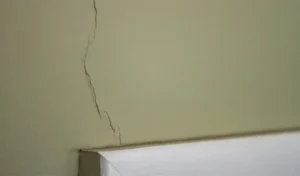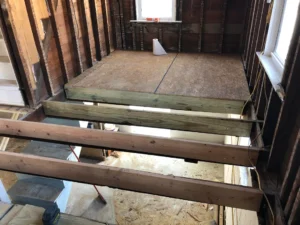A closet under the stairs can be one of the trickiest spaces to organize effectively. Often small and oddly shaped, these closets can easily become a messy catch-all area for random items, making it difficult to find what you need.
With some creative planning and a bit of work, you can transform this awkward space into a highly functional storage area.
This guide provides a detailed, step-by-step approach to organizing a small closet under the stairs, including everything from decluttering and arranging to incorporating clever storage solutions that maximize space.
With these tips, you can create a closet that’s both neat and practical, making it easier to keep your home tidy and stress-free. Let’s dive in to learn how you can make the most out of your small, unique closet space.
1. Assess the Space and Purpose of Your Closet
The first step is to determine how you want to use your closet under the stairs. Understanding the closet’s purpose will guide you in organizing it effectively and help you prioritize which items to store there.
1.1 Decide on the Function of the Closet
Consider what you most need this space for. Here are a few common uses:
- Coat and Shoe Storage: If you’re using it as a coat closet, focus on installing hooks or rods for jackets and racks for shoes.
- Cleaning Supply Closet: For cleaning tools, think about adding wall hooks for brooms and placing storage bins for supplies.
- General Storage: If it’s a multipurpose storage area, you’ll need versatile storage solutions, like bins or drawers that can fit a variety of items.
1.2 Measure the Dimensions of the Closet
Get a good sense of your closet’s dimensions, including the height, width, and depth of each section. Knowing the exact size will help you find storage containers, shelves, and hooks that fit perfectly.
2. Declutter and Empty the Closet
Before organizing, it’s crucial to remove all items from the closet. This will give you a clear view of the space and allow you to organize more effectively.
2.1 Sort Items by Category
Separate items into categories, such as shoes, cleaning supplies, winter gear, or tools. This will make it easier to decide what stays and what goes.
2.2 Decide What to Keep, Donate, or Discard
Go through each category and decide if you really need to keep everything. Items that are rarely used, duplicates, or broken should be considered for donation or disposal.
3. Clean and Prepare the Closet
With an empty closet, take some time to thoroughly clean and prep the area. A clean, fresh start helps set the stage for an organized and well-kept space.
3.1 Dust and Vacuum
Dust off shelves, walls, and any surfaces inside the closet. Use a vacuum cleaner with an attachment to reach into tight corners and remove any dirt or debris from the floor.
3.2 Paint or Add Wallpaper for a Refresh
Consider painting or adding wallpaper to give your closet a fresh look. Light colors can make the space feel bigger, while peel-and-stick wallpaper can add personality and design.
3.3 Consider Adding Lighting
If the closet is dark, install battery-operated LED lights or motion-sensor lights to illuminate the space. Good lighting makes it easier to find items and helps make the space more functional.
4. Choose Storage Solutions to Maximize Space
With your closet cleaned and prepped, it’s time to add storage solutions that will help you make the most out of the available space.
4.1 Install Adjustable Shelving
Adjustable shelves can provide flexible storage for various items. Place larger shelves for items like bags or bins near the bottom and smaller shelves for light items like hats or scarves higher up.
4.2 Use Hooks for Vertical Storage
Hooks are a great way to utilize vertical space. Install them on the door or walls to hang coats, bags, or umbrellas. Adhesive hooks work well for lighter items, while stronger wall hooks can handle heavier loads.
4.3 Add Pull-Out Bins and Drawers
Bins or drawers allow you to store smaller items in an organized way. Opt for stackable bins that fit neatly on the floor or shelves, or use drawers for easy access to items you use frequently.
4.4 Consider Rods for Hanging Items
If your closet is tall enough, a hanging rod can make a huge difference. Use it for hanging coats, jackets, or even bags to keep them off the floor.
4.5 Use the Back of the Door for Extra Storage
The back of the closet door offers valuable storage space. Over-the-door organizers or racks are perfect for holding shoes, cleaning supplies, or small items like gloves and hats.
5. Organize Items Based on Frequency of Use
To create a functional space, organize items based on how often you need to access them. Items you use more frequently should be more accessible, while seasonal or less-used items can go towards the back or higher up.
5.1 Place Everyday Items at Eye Level
If you’re using the closet to store everyday items, such as shoes or coats, make sure they’re easy to grab and put away. Placing these items at eye level or within easy reach will make the space much more functional.
5.2 Store Seasonal Items Higher or Lower
Seasonal items, like holiday decorations or winter clothing, don’t need to be as accessible year-round. Store them on high shelves or at the very back of the closet to free up space for items you use more often.
5.3 Use Small Bins for Tiny Accessories
For smaller items like keys, scarves, or gloves, use small bins or baskets. Label each bin to make finding items easy, and place them on a dedicated shelf or in a drawer.
6. Label Bins and Shelves for Easy Identification
Labels help everyone in the household know where to find (and put away) items. Labeling makes staying organized easier and minimizes clutter in the future.
6.1 Use Clear Containers or Bins with Labels
Clear containers allow you to see what’s inside without having to open them. If you prefer opaque bins, make sure they’re labeled so you know exactly what’s inside each one.
6.2 Use a Label Maker or Pre-Printed Labels
A label maker can create clean, professional labels, while pre-printed labels add a decorative touch. Use labels that are easy to read so everyone can quickly identify where items belong.
6.3 Color-Code for Different Categories
For added organization, you can use different colored bins or labels for different categories. For example, green labels for cleaning supplies and blue labels for seasonal gear.
7. Keep Floor Space Clear
Cluttered floor space can make your closet feel cramped. Keeping the floor clear will make it easier to step in and access your items without having to move things around.
7.1 Store Shoes on a Shoe Rack or Shelf
Instead of placing shoes directly on the floor, use a shoe rack or tiered shelf to keep them organized. This also makes it easier to see each pair at a glance.
7.2 Use a Rolling Cart for Mobility
If you need to store heavier items, consider using a rolling cart. This allows you to move items in and out of the closet without hassle, especially if you need to access items stored in the back.
8. Create a Maintenance Routine
Once your closet is organized, it’s important to maintain it to prevent it from getting cluttered again.
8.1 Regularly Purge Unnecessary Items
Make a habit of going through your closet every few months to clear out items you no longer need. This is especially helpful for seasonal items that may only be used part of the year.
8.2 Return Items to Their Designated Spot
Encourage everyone in the household to put items back in their designated spot. This small habit keeps your closet organized and makes finding items easier.
8.3 Check for Needed Adjustments
Over time, you might find that some parts of your setup aren’t working as expected. Don’t hesitate to adjust or rearrange to suit your needs better, as small changes can keep the closet functional.
9. Add Personal Touches for Motivation
Personalizing the closet can make it feel more welcoming and motivate you to keep it organized.
9.1 Add Small Decor Elements
Consider adding small decor pieces like a patterned rug or a mini mirror. This can make the closet more pleasant to use and give it a sense of style.
9.2 Choose Storage Solutions That Fit Your Style
Selecting bins, baskets, or shelving that match your aesthetic can make the organization process more enjoyable. Choose materials or colors that make you feel good about the space.
Conclusion
Organizing a small closet under the stairs may seem challenging, but with careful planning and the right storage solutions, you can transform it into an efficient and orderly space. By decluttering, maximizing storage options, and implementing a maintenance routine, you’ll keep your closet looking neat and make it much easier to access the items you need. With a bit of patience and creativity, your small closet under the stairs can become a valuable storage area that enhances the functionality of your home.




